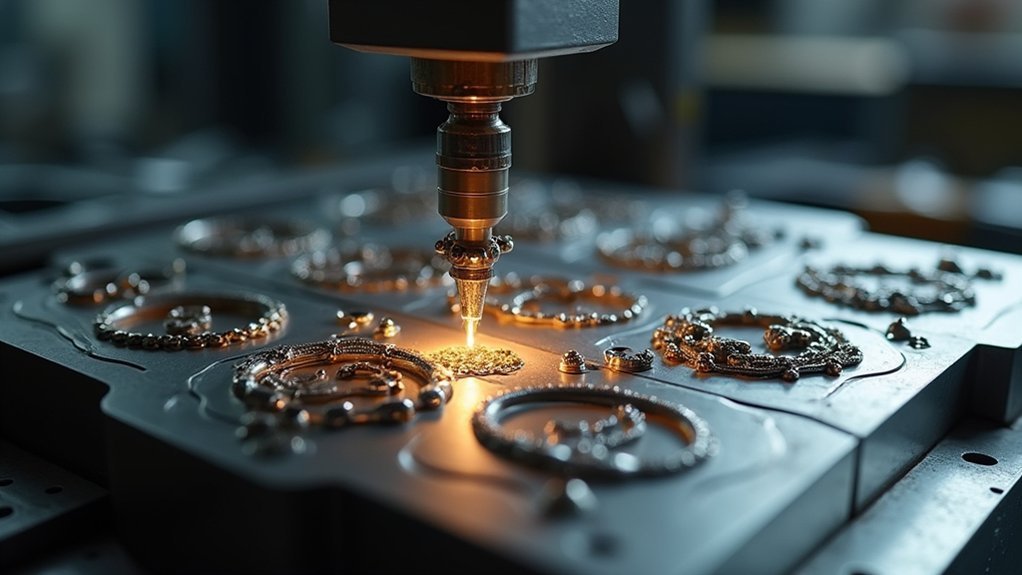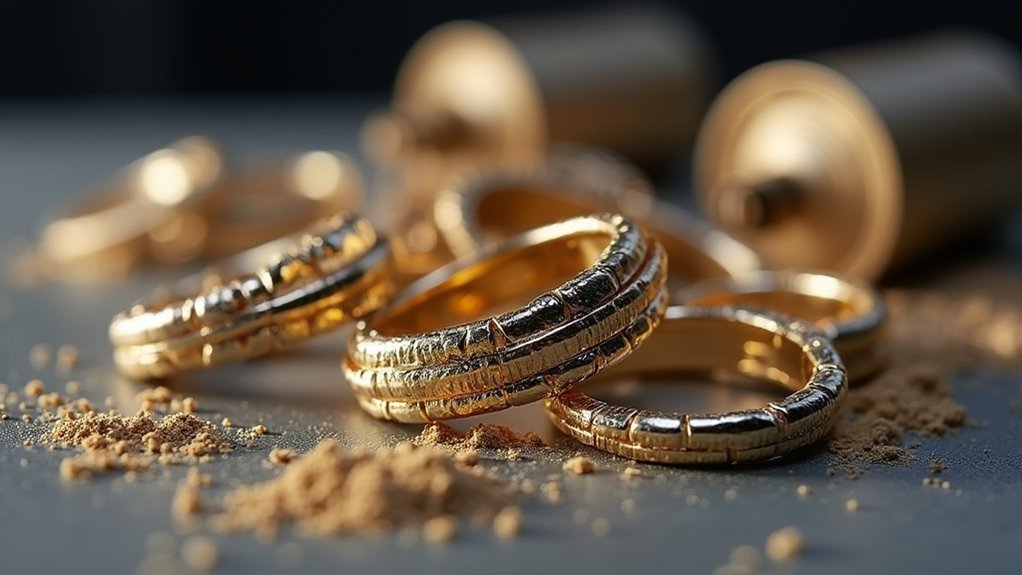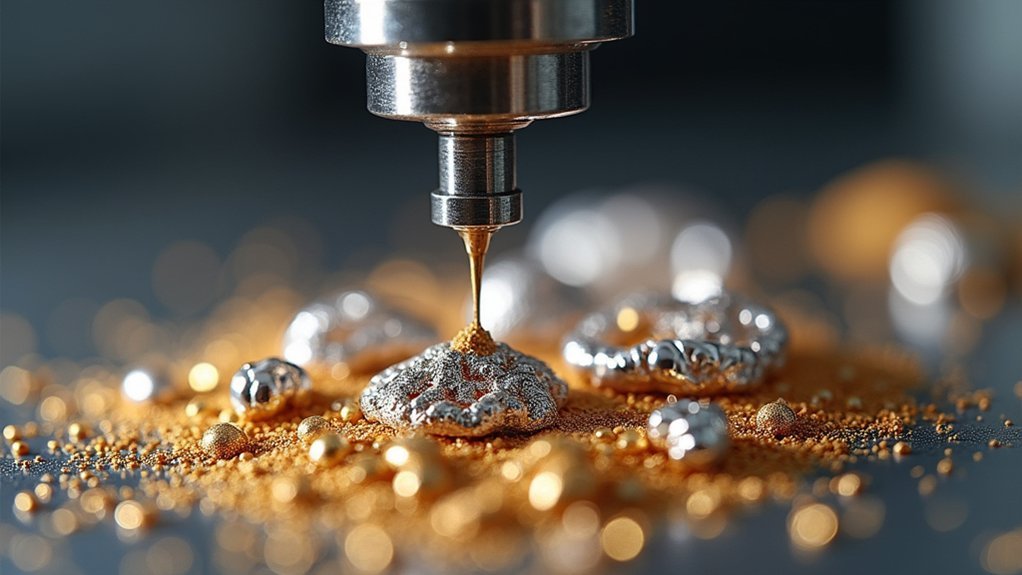Metal injection molding (MIM) for jewelry combines plastic injection molding’s precision with powdered metallurgy’s strength to create intricate jewelry pieces. You’ll start with feedstock containing thermoplastic binder and metal powder, which produces “green parts” 20% larger than finished pieces. The process works with precious metals like 18kt gold, silver, and platinum, achieving tolerances of +/- 0.1mm and wall thicknesses as thin as 0.3mm. This technique enables complex designs impossible with traditional methods while minimizing material waste. Below, you’ll discover the complete manufacturing process and cost considerations.
Understanding the Metal Injection Molding Process for Jewelry Manufacturing

When you’re looking to create intricate jewelry pieces with complex geometries and fine details, Metal Injection Molding (MIM) offers a revolutionary manufacturing approach that combines the precision of plastic injection molding with the strength of powdered metallurgy.
The MIM process starts with pelletized feedstock containing thermoplastic binder and metal powder, which you inject into molds to create “green parts” approximately 20% larger than finished pieces.
Metal powder and thermoplastic binder combine in pelletized feedstock, injected into molds to form oversized green parts before final processing.
Through debinding and sintering, your metal injection molded components achieve mechanical properties comparable to cast jewelry while enabling intricate designs previously impossible with traditional methods.
This technology supports production of jewelry from precious metals like 18ct gold, delivering exceptional design flexibility for high-volume production with tight tolerances of +/- 0.3–0.5%.
Materials Compatible With MIM Jewelry Production
While traditional jewelry manufacturing limits your material choices, MIM technology opens up an expansive palette of precious metals and alloys for your jewelry production needs.
You’ll find metal injection molding compatible with 18kt gold, silver, and platinum, enabling you to create pieces with high detail and complexity that traditional methods can’t match efficiently.
The powdered metal format delivers superior mechanical properties, ensuring your jewelry maintains strength while remaining lightweight.
You’ll achieve complex geometries and fine features that result in durable and aesthetically pleasing pieces.
With up to 98% material conversion into usable parts, you’ll greatly reduce waste compared to conventional manufacturing.
This versatility in precious metals and alloys enhances your design possibilities while maintaining cost-effectiveness in your jewelry production process.
Advantages of Metal Injection Molding for Jewelry Makers

You’ll discover that metal injection molding transforms how you approach jewelry creation by offering unprecedented design freedom that lets you craft intricate shapes impossible with traditional methods.
This manufacturing process delivers cost-effective production through minimal material waste and efficient multi-component molding, considerably reducing your overall expenses.
You’re also empowered with superior material options, including precious metals like gold and platinum, giving you the flexibility to meet diverse customer preferences while maintaining exceptional quality standards.
Design Freedom Benefits
Although traditional jewelry manufacturing methods like casting and machining have served the industry for decades, metal injection molding breaks through their design limitations by enabling you to create intricate geometries that were previously impossible or prohibitively expensive to produce.
MIM provides unprecedented design flexibility, allowing you to produce intricate parts with fine details and thin walls while maintaining structural integrity. You’ll achieve high dimensional accuracy with tolerances as close as +/- 0.001, ensuring your designs meet exact specifications.
The process supports various precious metal alloys, giving you creative freedom to develop unique pieces. Additionally, you can manufacture multiple components in one mold, reducing manufacturing costs while creating lightweight pieces that don’t compromise on quality or aesthetic appeal.
Cost-Effective Production Methods
Beyond the design possibilities, metal injection molding transforms your bottom line through exceptional cost efficiency.
You’ll achieve up to 98% material utilization, dramatically reducing material waste compared to traditional manufacturing methods. This automated process eliminates expensive manual labor while maintaining high precision for complex shapes.
The production of parts becomes remarkably streamlined when you’re creating high volumes. MIM serves as a cost-effective solution that doesn’t compromise quality—you’ll produce durable jewelry with superior mechanical properties at competitive prices.
The technology’s ability to handle intricate geometries means you won’t need secondary operations that inflate costs.
You’re fundamentally getting mass production capabilities without sacrificing the detailed craftsmanship your customers expect, making every piece both profitable and premium.
Superior Material Options
Metal injection molding releases an impressive arsenal of material choices that traditional jewelry manufacturing simply can’t match.
You’ll gain access to precious metals like 18ct gold while maintaining superior material options that enable intricate designs previously impossible to achieve. This process delivers consistent quality through high repeatability, ensuring every piece meets your exact specifications.
The technology’s capacity for complex geometries transforms your creative possibilities:
- Precious metal flexibility – Work with gold, silver, and platinum with minimal material waste
- Enhanced durability and performance – Integrate multiple features into single components for stronger pieces
- Design freedom – Create elaborate patterns and fine details that traditional methods can’t replicate
You’re no longer constrained by conventional manufacturing limitations, opening doors to innovative jewelry concepts that combine aesthetic appeal with structural integrity.
Design Capabilities and Complex Geometries in MIM Jewelry

You’ll discover that MIM technology transforms how you approach jewelry design by enabling intricate patterns that traditional manufacturing simply can’t achieve.
The process allows you to create miniature components with wall thicknesses as thin as 0.3 mm while maintaining precision tolerances of +/- 0.1 mm.
You can now integrate multiple functions into single components, eliminating complex assembly steps and opening new possibilities for innovative jewelry designs.
Intricate Pattern Creation
When traditional jewelry manufacturing methods reach their limits with complex designs, Metal Injection Molding steps in to reveal unprecedented creative possibilities.
You’ll discover that MIM enables intricate designs with complex geometries that were previously impossible to achieve. This technology lets you create delicate patterns, fine textures, and detailed engravings with remarkable precision using precious metals like 18ct gold alloys.
The process excels at producing high-quality jewelry with consistent pattern reproduction across multiple pieces.
You’ll benefit from reduced material waste and lower production costs, making it a cost-effective solution for mass production without sacrificing detail quality.
- Fine Detail Accuracy: Create microscopic patterns and textures with consistent repeatability
- Integrated Design Elements: Combine multiple decorative features into single components
- Thin Wall Capabilities: Achieve delicate, lightweight structures with intricate internal geometries
Miniature Component Precision
Although jewelry components continue shrinking in size while demanding greater complexity, MIM technology delivers exceptional precision that transforms how you approach miniature design challenges.
Metal injection molding achieves tight tolerances of +/- 0.001 inches, enabling you to create intricate miniature components that traditional manufacturing methods can’t match.
You’ll find this high precision particularly valuable when developing complex geometries for rings, earrings, and pendant details. The process allows you to integrate multiple functions into single components, creating lightweight yet durable pieces without assembly requirements.
With material selection including precious metals like 18ct gold, you can explore innovative jewelry designs while maintaining luxury standards. MIM’s exceptional accuracy guarantees your finest details remain crisp and consistent across production runs.
Cost Analysis of MIM Versus Traditional Jewelry Manufacturing Methods
Understanding the financial implications of Metal Injection Molding versus traditional jewelry manufacturing methods requires examining both immediate and long-term cost factors.
Your cost analysis reveals that MIM considerably reduces manufacturing costs through minimal material waste, achieving 98% feedstock conversion compared to traditional methods with higher scrap rates.
However, you’ll face substantial initial equipment investments that impact low-volume production viability.
Initial equipment costs for MIM technology create significant barriers for jewelry manufacturers operating smaller production volumes.
- Material Efficiency: MIM converts up to 98% of metal feedstock into usable parts versus higher waste rates in traditional casting
- Labor Costs: Mass production capabilities provide economic advantage for larger production runs compared to labor-intensive traditional techniques
- Lead Times: Combined manufacturing steps reduce production time, unlike extensive assembly processes required by conventional methods
For larger production runs, MIM’s reduced labor costs and shorter lead times offset initial investments.
Quality and Precision Standards in Metal Injection Molded Jewelry
Precision becomes paramount when evaluating Metal Injection Molding’s capability to meet the exacting standards required for fine jewelry production. You’ll achieve dimensional tolerances as tight as +/- 0.001 inches through metal injection molding, surpassing traditional methods. This precision enables intricate designs and complex geometries that were previously impossible.
| Quality Aspect | MIM Advantage | Jewelry Benefit |
|---|---|---|
| Dimensional Tolerances | +/- 0.001 inches | Perfect fit components |
| Surface Finish | Superior smoothness | Reduced polishing time |
| Density Achievement | 95-99% theoretical | Enhanced durability |
| Alloy Consistency | Homogeneous distribution | Uniform color/properties |
| Geometric Complexity | Unlimited design freedom | Innovative styling options |
The sintering process creates high-density pieces with exceptional mechanical properties. You can work with precious metal alloys including 18ct gold while maintaining consistent quality across production runs.
Production Volume Considerations for MIM Jewelry Applications
When evaluating Metal Injection Molding for jewelry production, you’ll find that volume requirements fundamentally determine the process’s economic viability.
MIM excels in high-volume jewelry applications where you’re producing thousands of pieces, as the initial tooling costs become justified through mass production runs. You’ll achieve considerable cost savings per part when manufacturing intricate designs at scale.
The process delivers exceptional uniformity across large production volumes, ensuring consistent quality in every piece. While traditional methods struggle with complex geometries, MIM handles detailed components efficiently with minimal waste.
Key volume considerations include:
- Minimum quantities: Typically 1,000+ pieces to justify tooling investments
- Cost per part: Decreases considerably as production volume increases
- Precious metals integration: Economically viable for large-scale jewelry manufacturing
Surface Finishing and Post-Processing Requirements for MIM Jewelry
Although MIM produces near-net-shape jewelry components with excellent dimensional accuracy, you’ll need to implement thorough post-processing to achieve the premium surface quality that consumers expect. The sintering process leaves rough textures and imperfections that require additional finishing processes to meet aesthetic quality standards.
| Process | Purpose | Target Result |
|---|---|---|
| Polishing | Remove roughness | Ra < 0.8 µm |
| Electroplating | Apply precious metals | Gold/rhodium coating |
| Chemical Treatment | Enhance durability | Improved wear resistance |
Post-processing techniques directly impact both appearance and mechanical properties of your jewelry pieces. You’ll typically need multiple steps to achieve a high-quality finish, balancing aesthetic requirements with functional performance. The chosen surface finishes affect wear resistance, making careful selection essential for long-term durability.
Frequently Asked Questions
What Is the Metal Injection Molding Process?
You’ll inject metal powder mixed with thermoplastic binder into molds under high pressure, creating green parts. You’ll then remove the binder and sinter at high temperatures, fusing particles into dense components.
What Are the Disadvantages of Metal Injection Molding?
You’ll face high start-up costs, significant design change expenses, lengthy tooling lead times, limited flexibility for modifications, and surface finish limitations that require additional processing steps for quality results.
What Is the Difference Between Metal Casting and Injection Molding?
You’ll find metal casting pours molten metal into molds for larger, simpler parts, while injection molding uses powdered metal with binders for complex, detailed components with superior density and strength.
What Are the Benefits of Metal Injection Molding?
You’ll achieve precise tolerances up to +/- 0.001 inches, reduce material waste by 98%, create complex designs impossible with traditional methods, and cut production costs considerably while working with precious metals.





Leave a Reply